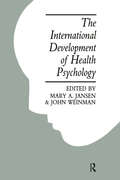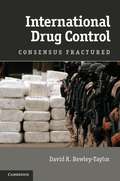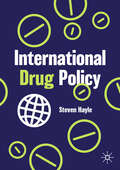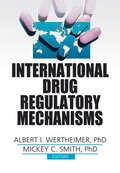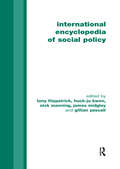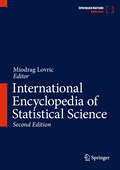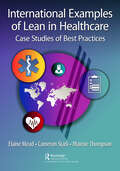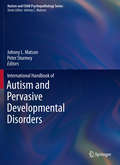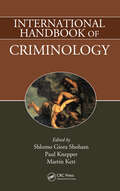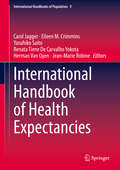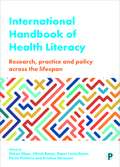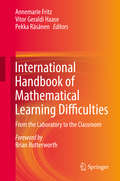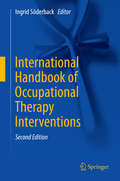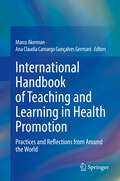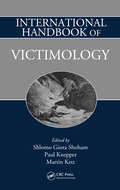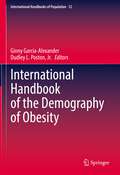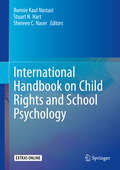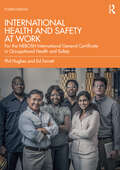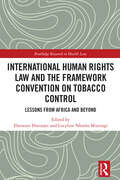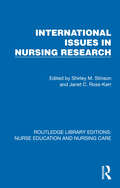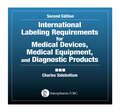- Table View
- List View
International Development Of Health Psychology
by John Weinman Mary A. JansenFirst Published in 1991. With any new area of research, particularly one in which development has been so rapid and influential, it is important to take stock of progress and identify critical issues. Health Psychology shows great potential both as a research area and a profession, and the careful planning of good quality research and of appropriately structured training programs if imperative if this potential is to be realised. this book explores the way in which this discipline has developed internationally and the nature of different types of training programs which have emerged. This book is intended for health psychologists who are interested in the latest developments in their field around the world and will be particularly valuable to those responsible for training programs.
International Disaster Nursing
by Robert Powers Elaine DailyThe effects of a disaster on healthcare can range from conditions that immediately besiege the system with large numbers of patients, to catastrophes that strain its long-term sustainability. Nurses, as frontline health professionals, must have an understanding of the situations they may face before, during and after a disaster and they must develop the skills and strategies to provide effective and immediate care. International Disaster Nursing is the first truly comprehensive and internationally focused resource to address the diversity of issues and myriad scenarios that nurses and other health personnel could encounter during a disaster event. This text defines the many roles of the nurse within a multidisciplinary team, and aids the implementation of the community's disaster plans in a crisis. With an alarming increase in the occurrence of disasters in the last decade, International Disaster Nursing is the hallmark text in the field.
International Drug Control
by David R. Bewley-TaylorThere remains substantial agreement among the international community on many aspects of the contemporary UN drug control regime. However, diverging views on the non-medical and non-scientific use of a range of controlled substances make drug policy an increasingly contested and transitionary field of multinational cooperation. Employing a fine-grained and interdisciplinary approach, this book provides the first integrated analysis of the sources, manifestations and sometimes paradoxical implications of this divergence. The author develops an original explanatory framework through which to understand better the dynamic and tense intersection between policy shifts at varying levels of governance and the regime's core prohibitive norm. Highlighting the centrality of the harm reduction approach and tolerant cannabis policies to an ongoing process of regime transformation, this book examines the efforts of those actors seeking to defend the existing international control framework and explores rationales and scenarios which may lead to the international community moving beyond it.
International Drug Policy
by Steven HayleThis textbook provides an overview of international drug policy using a comparative framework to explore contemporary drug issues. Using a topical approach, each chapter examines a different topic pertaining to drug policy to illustrate the range of contrasting approaches adopted including: decriminalisation, prohibition, legalisation, and harm reduction. In this way, it speaks to students in the field of criminology and justice and beyond with a focus on criminal laws and the administration of criminal justice. It draws on global examples from over 30 countries throughout to discuss and compare drug policies. The book includes a host of pedagogic features including case studies, exercises, study questions, web resources and chapter summaries. It starts by providing an overview of the psychoactive and pharmacological effects of illicit drugs, discusses how to compare policies across many countries, and provides a history of the global drug prohibition regime and how it is evolving internationally. Many of the chapter topics that follow relate to “drug control regimes” which are different forms of regulatory strategies found operating in many countries around the world. It also discusses the global movement toward the decriminalization of all drugs. It incorporates multidisciplinary, theoretical and methodological approaches drawing on the work of a wide range of scholars including historians, political scientists, sociologists, psychologists, economists, and lawyers.
International Drug Regulatory Mechanisms
by Albert I. WertheimerLearn how international governments have committed themselves to improving access to quality health care! International Drug Regulatory Mechanisms explores the environment, organization, structure, functioning, and finance of health systems and pharmaceutical markets in 19 countries. Local experts describe each country&’s experiences with and lessons learned from the regulation of pharmaceutical products. This book will help government officials, pharmacy educators, and pharmaceutical industry leaders from around the globe identify and develop successful methods for controlling pharmaceutical drug prices and utilization. In International Drug Regulatory Mechanisms, you will learn about the health care system of each country and each government&’s measures to control drug costs. This text shows you what government interventions are feasible as well as effective, and the impact of these measures on consumers, government agencies, and the pharmaceutical companies and distributors. Drug policies, reimbursement concepts, and health insurance companies are all examined to give you a better working knowledge of the methodology and guidelines involving drug control in nations such as: Iceland Canada Israel Malaysia Argentina Taiwan Mexico Italy International Drug Regulatory Mechanisms is an extensive text that shows how pharmaceuticals are regulated throughout the world. This book examines how-despite similar goals-price controls, utilization controls, record keeping, and quality requirements differ greatly between countries. Using numerous graphs, tables, and figures, this one-of-a-kind resouce provides you with new insight into which strategies are superior and how to implement these strategies in your own country.
International Encyclopedia of Social Policy: 3-volume Set
by James Midgley Huck-Ju Kwon Gillian Pascall Nick Manning Tony FitzpatrickAvailable in paperback for the first time, this milestone work offers an in-depth treatment of all aspects of the discipline and practice of social policy globally. Supported by a distinguished international advisory board, the editors have compiled almost 900,000 words across 734 entries written by 284 leading specialists to provide authoritative coverage of concepts, policy actors, welfare institutions and services along a series of national, regional and transnational dimensions. Also included are biographical entries on major policy makers and shapers. The editors have particularly striven to provide strong coverage of differing geographical and cultural traditions so that the variety of social policy, as both an academic discipline and a domain of governance, is reflected. Contributors draw in and make the necessary connections with social policy's associated disciplines to provide a rich picture of this vast and highly diverse field. Comprehensive and authoritative, the Encyclopedia has sought to open up rather than to foreclose the numerous areas in which there is on-going research, debate and, sometimes, serious disagreement and divergence in theory and practice. To this end, entries attempt to introduce a core or common ground of understanding before moving on to a wider discussion of debates regarding different conceptual and geographical approaches. The whole is integrated by cross-referencing and each entry includes a bibliography for further reading. There is a full index. The International Encyclopedia of Social Policy provides the most substantial mapping of the international study and practice of social policy to date and will stand as a vital storehouse of knowledge for many years to come.
International Encyclopedia of Statistical Science
by Miodrag LovricThe International Encyclopedia of Statistical Science stands as a monumental effort to enrich statistics education globally, particularly in regions facing educational challenges. By amalgamating the expertise of over 700 authors from 110 countries, including Nobel Laureates and presidents of statistical societies, it offers an unparalleled resource for readers worldwide. This encyclopedia is not just a collection of entries; it is a concerted effort to revive statistics as a vibrant, critical field of study and application. Providing a comprehensive and accessible account of statistical terms, methods, and applications, it enables readers to gain a quick insight into the subject, regardless of their background. This work serves to refresh and expand the knowledge of researchers, managers, and practitioners, highlighting the relevance and applicability of statistics across various fields, from economics and business to healthcare and public policy. Furthermore, it aims to inspire students by demonstrating the significance of statistics in solving real-world problems, thus encouraging a new generation to explore and contribute to the field.
International Examples of Lean in Healthcare: Case Studies of Best Practices
by Elaine Mead, Cameron Stark, and Maimie ThompsonTypically entrenched and systemic, healthcare problems require the sort of comprehensive solutions that can only be addressed by a change in culture and a shift in thinking. Organizations around the world are using Lean to redesign care and improve processes in a way that achieves and sustains meaningful results for patients, staff, physicians, and health systems. This book demonstrates how honest appraisal, intelligent planning, and vigilant follow-up have led to dramatic improvements in a variety of healthcare settings across the world. It teaches us how innovative organizations can find sustainable solutions to seemingly intractable problems by following a path guided by Lean Thinking. Lean methods may not solve every healthcare problem, but as these cases prove, changing a culture rather than personnel results in more effective sustainable change. This multi-authored book provides expert descriptions of Lean methods and their application in healthcare, written by the people who developed and tested the methods in healthcare settings. Each chapter brings together a description of the technique or approach, with examples of application in practice from the author’s own practice. Authors use an engaging approach to their narrative, with examples from their personal experience or engagement being described to illustrate the practical application of theoretic approaches. In painting a picture of the environment in which these tools and techniques have been applied, readers will understand the transferability to their own workplace environment. This will be an opportunity to tell real stories of the application of Lean in healthcare and give readers the opportunity to learn from people from across the world, on subjects on which they are acknowledged topic experts, based on day-to-day Lean practice.
International Handbook of Autism and Pervasive Developmental Disorders
by Johnny L. Matson Peter SturmeyBased on a solid historical foundation of autism theory and research, this inclusive handbook integrates coverage of the broader scholarly literature with a trenchant analysis of the state of the field in nosology, etiology, assessment, and treatment.
International Handbook of Criminology
by Paul Knepper Shlomo Giora Shoham Martin KettThe second handbook in the Shoham trilogy, which includes the esteemed International Handbook of Penology and Criminal Justice and the upcoming International Handbook of Victimology, this volume is a comprehensive treatment of criminology theory. This text contains contributions from 25 of the top international scholars in the field across a wide range of disciplines. Topics include social deviance, research methods, biological and physiological explanations, personality types, and family socialization processes. The book also explores ecological and economic factors, differential association and situational crime prevention, cultural conflicts and immigration, as well as stigmas, group delinquency and juvenile delinquency.
International Handbook of Elder Abuse and Mistreatment
by Mala Kapur ShankardassThis first-of-its-kind work on elder abuse and mistreatment provides a comprehensive and up-to-date overview of the subject. Covering almost all regions of the world, it highlights different dimensions of elder abuse and mistreatment in terms of their prevalence, incidence, prevention, treatment, management and response from governments and civil society, academic and research communities, and society in general. Written by international specialists from various disciplinary and presenting the latest findings and data, the handbook includes sections on the Americas; the Caribbean; Europe; Central, West and South Asia; East Asia and Asia-Pacific; and Africa. The chapters offer clarity on the concept and forms of elder abuse and neglect, discuss research methodology, and provide policy options, legislative solutions and programmatic responses to give relief to older people as victims of abuse and neglect as well as to deal with the perpetrators. This book is intended for a wide range of students and researchers interested in aging, from sociology, to social work, community medicine, public health, clinical psychology, and human rights/law.
International Handbook of Health Expectancies (International Handbooks of Population #9)
by Eileen M. Crimmins Jean-Marie Robine Carol Jagger Yasuhiko Saito Renata Tiene De Carvalho Yokota Herman Van OyenThis handbook presents global research on health expectancies, a measure of population health that examines the interaction between quantity and quality of life. With data from Europe, North America, Asia, and beyond, it explains how to define and measure health and morbidity and how to integrate these measurements with mortality. Coverage first highlights long-term trends in longevity and health. It also considers variations across and within countries, inequalities, and social gaps as well as micro and macro-level determinants. Next, the handbook deals with the methodological aspects of calculating health expectancies. It compares results from different methods and introduces tools, such as decomposition tool for decomposing gaps, an attrition tool for attributing a medical cause to reported disability, and a tool for measuring policy impact on health expectancies. It introduces methods of forecasting health expectancies. The handbook then goes on to examine the synergies and/or trade-off between longevity and health as well as considers such topics as the compression versus the expansion of morbidity/disability and the health-survival paradox. The last section considers new concepts and dimensions of health and, more broadly, well being which can be used in summary measures of population health, including psychological factors. Researchers, clinicians, demographers, and health planners will find this handbook an essential resource to this increasingly important public health and social policy tool. It will help readers gain insight into changes in health over time as well as inequalities between countries, regions, and population subgroups.
International Handbook of Health Literacy: Research, Practice and Policy across the Life-Span
by Ullrich Bauer Orkan Okan Diane Levin-Zamir Paulo Pinheiro Kristine SørensenAvailable Open Access under CC-BY-NC license. Health literacy addresses a range of social dimensions of health including knowledge, navigation, communication as well as individual and organizational skills for accessing, understanding, evaluating and using of information. Especially over the past decade, health literacy has become a major public health concern globally as an asset for promoting health, wellbeing and sustainable development. This comprehensive handbook provides an invaluable overview of current international thinking about health literacy, highlighting cutting edge research, policy and practice in the field. With a diverse team of contributors, the book addresses health literacy across the life-span and offers insights from different populations and settings. Providing a wide range of major findings, the book outlines current discourse in the field and examines necessary future dialogues and new perspectives.
International Handbook of Mathematical Learning Difficulties: From the Laboratory to the Classroom
by Pekka Räsänen Annemarie Fritz Vitor Geraldi HaaseThis comprehensive volume provides teachers, researchers and education professionals with cutting edge knowledge developed in the last decades by the educational, behavioural and neurosciences, integrating cognitive, developmental and socioeconomic approaches to deal with the problems children face in learning mathematics.The neurocognitive mechanisms and the cognitive processes underlying acquisition of arithmetic abilities and their significance for education have been the subject of intense research in the last few decades, but the most part of this research has been conducted in non-applied settings and there’s still a deep discrepancy between the level of scientific knowledge and its implementation into actual educational settings. Now it’s time to bring the results from the laboratory to the classroom. Apart from bringing the theoretical discussions to educational settings, the volume presents a wide range of methods for early detection of children with risks in mathematics learning and strategies to develop effective interventions based on innovative cognitive test instruments. It also provides insights to translate research knowledge into public policies in order to address socioeconomic issues. And it does so from an international perspective, dedicating a whole section to the cultural diversity of mathematics learning difficulties in different parts of the world. All of this makes the International Handbook of Mathematical Learning Difficulties an essential tool for those involved in the daily struggle to prepare the future generations to succeed in the global knowledge society.
International Handbook of Occupational Therapy Interventions
by Ingrid SöderbackResources for rehabilitation specialists tend to follow a straight line: injury--disability--limitation--intervention. The International Handbook of Occupational Therapy Interventions breaks with this tradition, organized by type of intervention (based on recommendations in the International Classification of Functioning) rather than disability, medical condition, or level of impairment. This innovative, user-friendly system identifies candidates for particular interventions in terms of the range of syndromes and illnesses they are applicable to, encouraging critical thinking, problem solving, and best practice. The book's wide spectrum of interventions coupled with its international perspective creates a unique source of evidence-based strategies for improving patients' adaptation, functioning, relearning, recovery, and the prevention of ill health. The Handbook: Describes interventions in such areas as environmental accessibility, ergonomics, pain management, sensory functional training, electric prostheses, music therapy, psychoeducation, and cognitive teaching. Features interventions suited to all areas of daily life: self maintenance, home, work, and leisure. Clarifies the occupational therapist's role in multidisciplinary care. Includes material on accident/illness prevention and health promotion strategies. Supplies reference lists of studies regarding the clinical efficacy of interventions. Demonstrates the use of a common technical language for the field. Occupational and physical therapists, rehabilitation nurses and technicians, physiatrists, and health psychologists will find the International Handbook of Occupational Therapy Interventions a source of practice-enhancing tools and ideas. Its clarity of presentation makes it highly useful to readers in related fields (such as insurance case workers and ergonomic architects and engineers) as well.
International Handbook of Teaching and Learning in Health Promotion: Practices and Reflections from Around the World
by Marco Akerman Ana Claudia Camargo Gonçalves GermaniThis international handbook brings together researchers and teachers from 25 countries of the five continents to share their experiences of teaching health promotion in undergraduate and graduate courses related to different health professions. Chapter authors share teaching methodologies used in classes, discuss the competencies students need to learn and indicate research opportunities. Readers will be provided with real-world examples of empowering, participatory, holistic, intersectoral, equitable and sustainable teaching/learning strategies that aim to improve health and reduce health inequities. This handbook was edited by an editorial board formed by 12 members of the International Union for Health Promotion and Education (IUHPE) from seven countries – Brazil, Belgium, Canada, Israel, New Zealand, Taiwan and UK –, and includes 45 chapters organized in seven thematic sections, each one dedicated to a different aspect of the process of teaching and learning health promotion: The health promotion curriculum Making health promotion relevant to practice Pedagogies for health promotion Special topics for health promotion Health promotion assessment and quality assurance Health promotion as a transformational practice Students’ reflections The International Handbook of Teaching and Learning in Health Promotion: Practices and Reflections from Around the World aims to encourage a dialogue between teaching and learning practices carried out locally and the possibilities of replicating these experiences globally, recognizing cultural differences and similarities. This handbook is intended for a wide range of readers, including education and training providers, health professionals and health care students. Due to its intersectoral and interdisciplinary approach, it will also be of interest to teachers and students in other fields of the Social Sciences, such as Urban Planning, Social Work, Public Policy, International Relations and Population Studies.
International Handbook of Victimology
by Paul Knepper Shlomo Giora Shoham Martin KettIn the nearly four decades since the First International Symposium on Victimology convened in Jerusalem in 1973, some concepts and themes have continued to hold a prominent place in the literature, while new ones have also emerged. Exploring enduring topics such as conceptions of victimhood, secondary and hidden victimization, and social services f
International Handbook of the Demography of Obesity (International Handbooks of Population #12)
by Dudley L. Poston Ginny Garcia-AlexanderThis handbook provides a demographic examination of global obesity trends by bringing together the range of research conducted in this field by demographers, sociologists, epidemiologists, and other quantitatively and demographically oriented social scientists. It utilizes a multidisciplinary demographic approach to provide insights into the global prevalence and mechanisms of obesity, as well as the population level impacts of rising obesity. Major sections include: global obesity trends and prevalence; obesity and demographic structures, processes, and characteristics; emerging areas of study; and obesity in LGBAT populations. This handbook provides readers with a broad understanding of population-based research on obesity and serves as a resource for scholars, students, policymakers, and researchers.
International Handbook on Child Rights and School Psychology
by Bonnie Kaul Nastasi Stuart N. Hart Shereen C. NaserThis handbook examines the meanings, implications, and transformative potential of a child-rights approach for school psychology. It focuses on the school community, in which psychology is committed to promoting well-being, learning, and development of all children. The handbook begins with an overview of the 1989 United Nations Committee on the Rights of the Child (CRC) and explores main themes such as, survival, protection, development, participation, and nondiscrimination. Chapters provide guidance in promoting and protecting child rights when dealing with critical issues relevant to the school community, including well-being, freedom from violence, and access to high quality education. In addition, chapters analyze and offer recommendations for child rights applications within the roles and responsibilities of school psychologists. The handbook concludes with future directions for achieving a child-rights approach for school psychology. Topics featured in this handbook include:The current status of child rights in the international community.Accountability for child rights by school psychology.Collaborative home, school, and community practices aimed at promoting family support.Protecting child rights within the realm of competitive sports.CRC and school-based intervention programming.Promoting child rights through school leadership.Applying child rights-respecting research to the study of psychological well-being. The International Handbook on Child Rights and School Psychology is a must-have resource for researchers, scientist-practitioners, clinicians, and graduate students in child and school psychology, educational policy and politics, social work, public health, and other school-based or child-serving mental health disciplines.
International Health and Aid Policies: The Need for Alternatives
by Jean-Pierre Unger Pierre De Paepe Kasturi Sen Werner SoorsInternational health and aid policies of the past two decades have had a major impact on the delivery of care in low and middle-income countries. This book argues that these policies have often failed to achieve their main aims, and have in fact contributed to restricted access to family medicine and hospital care. Presenting detailed evidence, and illustrated by case studies, this book describes how international health policies to date have largely resulted in expensive health care for the rich, and disjointed and ineffective services for the poor. As a result, large segments of the population world-wide continue to suffer from unnecessary casualties, pain and impoverishment. International Health and Aid Policies arms health professionals, researchers and policy makers with strategies that will enable them to bridge the gaps between public health, medicine and health policy in order to support robust, comprehensive and accessible health care systems in any political environment.
International Health and Safety at Work Revision Guide: for the NEBOSH International General Certificate in Occupational Health and Safety
by Ed FerrettThis companion to the renowned International Health and Safety at Work textbook by Hughes and Ferrett is an essential revision aid for students preparing for their written assessments on the NEBOSH International General Certificate in Occupational Health and Safety. Fully updated to the 2019 specification, the revision guide provides complete coverage of the syllabus in bite-sized chunks, helping readers to learn and memorise the most important topics. Throughout the book, the guide links back to the International Health and Safety at Work textbook, helping students to consolidate their learning. Small and portable making it ideal for use anywhere – at home, in the classroom or on the move – the revision guide suggests useful tips on study and examination technique. It includes practice questions and answers based on NEBOSH exam questions, providing everything you need for productive revision in one handy reference. Now in its third edition, the International Health and Safety Revision Guide, written by the renowned health and safety author and former NEBOSH Vice Chairman Ed Ferrett, is an invaluable tool for students as they prepare for their NEBOSH exam and for their subsequent health and safety work.
International Health and Safety at Work: for the NEBOSH International General Certificate in Occupational Health and Safety
by Ed Ferrett Phil Hughes MBEInternational Health and Safety at Work has been specially written in simple English for the thousands of students who complete the NEBOSH International General Certificate in Health and Safety each year. Fully revised in alignment with the 2019 syllabus, this fourth edition provides students with all they need to tackle the course with confidence. Clear, easily accessible information is presented in full colour, with discussion of essential principles such as ILO and OSH conventions as well as legal frameworks from a range of countries. The book features practice questions and answers to test knowledge and increase understanding. International Health and Safety at Work remains the most effective tool for those working to fit international health and safety standards to local needs and practice.
International Human Rights Law and the Framework Convention on Tobacco Control: Lessons from Africa and Beyond (Routledge Research in Health Law)
by Ebenezer Durojaye Lucyline Nkatha MurungiThis book reviews the challenges and opportunities in the implementation of the WHO Framework Convention on Tobacco Control (FCTC) at the regional and national levels in Africa. It contains an analysis of the relevant norms and monitoring mechanisms at the regional level, and case studies from selected African and other developing countries. The WHO has noted that tobacco use or exposure to tobacco is a major health risk factor for non-communicable diseases (NCDs). This volume highlights the importance of taking measures to control tobacco use in Africa with a view to preventing these risks. With contributions from experts from the Global South, the book provides a critical analysis of the role that human rights can play in mitigating the impact of tobacco use and NCDs, and the implementation of the FCTC. The book contains a systematic and in-depth analysis of how efforts to realise the right to health under international and regional law can help to address the incidence of tobacco use in the developing world. The collection will be an important resource for academics, researchers and policymakers working in the areas of public health law and international human rights.
International Issues in Nursing Research (Routledge Library Editions: Nurse Education and Nursing Care)
by Shirley M. Stinson Ross-Kerr, Janet C.Originally published in 1986 this book presents a review of specific international themes in nursing research, particularly methodological issues; policy and funding issues; preparation for nursing research and other perspectives such as publication and the role of professional associations in nursing research development. In the past, geographical political, cultural, educational and economic barriers all contributed to insularity in nursing, but the authors maintain that there are many common problems and the profession can benefit greatly by an exchange of ideas. The chapters were written by leading authorities in the UK, USA and Canada and the book will be of use to student and practising nurses.
International Labeling Requirements for Medical Devices, Medical Equipment and Diagnostic Products
by Charles SidebottomCompletely revised, this second edition provides the practical, hands-on labeling information needed to secure rapid regulatory approval, gain marketplace acceptance, and assure user comprehension. A complete guide to all aspects of advertising, labeling, and packaging, it explains the relevant laws, regulations, and requirements in major markets w
